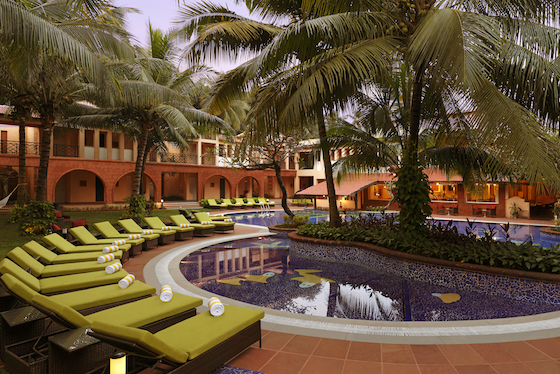As recently as 10 years ago, most hotel chains were only in India’s biggest cities, charging higher prices compared to surrounding countries. In smaller cities, independent hotels were often travelers’ only choice, says Manav Thadani, founder and chairman of?consultancy Hotelivate.
Fast-forward to today and the country’s booming economy is enriching younger generations, changing travel patterns in the process, Thadani says. Rather than families taking one annual summer vacation, this generation is more willing to go on smaller, multiple trips with their friends, both in India and internationally.
“There has been a shift in the thought process about traveling,” he says.

Contributed by Debbie Carlson
Luxury chains like Oberoi used to see occupancy of 80% foreigners and 20% Indians, but the ratio has shifted to 35% to 65%. “And the room rates haven’t changed. The Indian traveler is willing to spend a decent amount of money for the lifestyle he wants,” Thadani says.
Although India’s hospitality sector is seeing growth from in all tiers of?accommodation, budget and mid-range sectors are leading, says Vijay Thacker, director, Horwath HTL – India.
Mid-priced demand
In the budget sector, Oyo started out not unlike AirBnB, coordinating small guesthouse with lodgings in the eight-to-10-unit realm, with prices ranging from US$15 to US$25. But now the company is getting to the budget and mid-market hotel space, Thadani says. There’s fierce debate in India if Oyo is really a hotel company. (Oyo did not respond to interview requests.)
Regardless, Oyo “took the unorganized sector and gave it an organized feel,” Thadani says, later adding, “I think they need to be part of the mainstream, but you can’t really compare them (to traditional hotels).”
India’s middle-class growth created new demand for mid-priced hotels. Rattan Keswani, deputy managing director of New Delhi-based Lemon Tree Hotels, says for a while the options were extreme budget hotels or luxury lodging. Since opening in 2004, the company has grown to become India’s largest middle-market hotel chain, with 52 hotels among its Lemon Tree, Red Fox and Carnation brands.
The country’s huge transition makes getting a handle on traditional economic hospitality metrics tough, say Thadani and Thacker. For so long, much of the country’s hospitality industry was composed of under-the-radar guesthouses that aren’t counted as hotels, and in some areas it remains that way.
“India is such a vast country and we’ve got so many different dynamics in different parts of the country that general numbers aren’t representative,” Thacker says.
Occupancy is growing and rates are holding about steady, Thacker and Thadani agree. According to Hotelivate’s 2018 Indian Hospitality Trends and Opportunities report, occupancy for India’s total hotel sector stood at 67% in 2017-18, the highest in a decade, with RevPAR its best since 2010-11 at 3,837 rupees (US$58.85). Even with 9,000 rooms added in 2017 and continued growth in occupancy, the weighted average room rate rose only 1.5% over the previous fiscal year.
India is one of the top three fastest-growing destinations in the world by the World Travel & Tourism Council and is targeting 20 million foreign arrivals by 2022. That growth is attracting outside investors and companies. Hilton India, which has 19 hotels across five brands, aims to double its presence in the next three to four years, according to a spokesman.
The Indian lodging market could become the third-largest globally, but it needs support on a few fronts: its taxation structure, talent management and development of infrastructure in new and existing locations to increase business and leisure travel, the spokesman says.
Canadian investor Brookfield Asset Management has offered to buy debt-plagued Leela hotels (the offer had yet to be accepted at press time).
“Brookfield has been looking at the Indian the real estate space prettyaggressively,” says Thadani, adding that it is attracted by the country’s growth.
Tailoring offerings
Western chains wanting to compete in India need to adjust some of their offerings, Thacker says. For example, food options are just as important as the bed and the bathroom to the Indian guest. A big, elaborate buffet is important, especially in the budget to mid-range hotel.
“Some of the Western chains with their very limited-service product… that’s not going to (work). The Indian loves his room service,” he says.
Mandeep Lamba, president, South Asia, HVS Anarock, says about 25 million Indians traveled overseas in 2018, a number expected to double by 2020. The market size is expected to reach US$45 billion by 2022. Domestically the traditional areas like Rajasthan, Goa, Kerala and Uttar Pradesh are popular, with states like Tamil Nadu and Maharashtra rising stars.
Indians comfortable with traveling overseas are heading to neighboring Asian countries with Singapore and Thailand taking the lead, Lamba says. In long-distance travel, the U.S. is the favorite, followed by Europe.
“More and more Indians are looking at experiences during their travel including those with adventure, food and shopping. Accommodation offerings such as AirBnB are getting popular with Indians traveling abroad,” Lamba says.
Lemon Tree’s Keswani says the firm is eyeing the international Indian traveler and is opening brands in countries popular with Indians. It will open two hotels in Dubai this year – and is looking at other Arabian Gulf Coast countries, as well – and was poised to sign contracts in Thimpu and Katmandu, Nepal. And eventually, they want to consider places like Singapore, Bangkok and New York City.
“We work our demand and supply based on cities that have the largest number of (Indian) arrivals in those countries,” he says.
